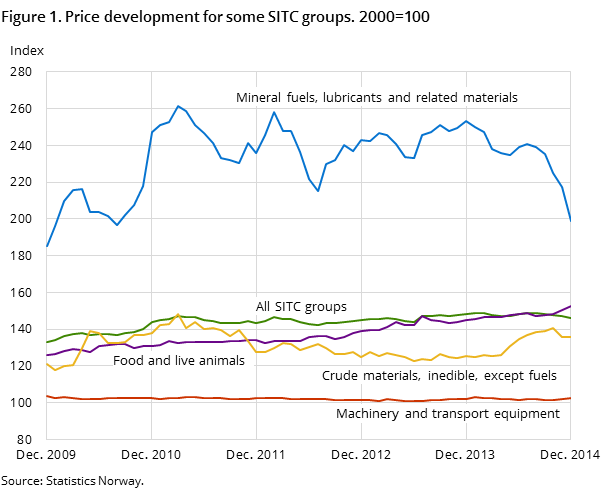Content
Published:
This is an archived release.
Continued price decrease in PIF
The price index of first-hand domestic sales (PIF) decreased by 0.8 per cent from November to December 2014. The price fall was due to price declines on petroleum and petroleum products as well as natural and manufactured gas.
| Per cent | Per cent | Index | Weights1 | |
|---|---|---|---|---|
| December 2014 / November 2014 | December 2014 / December 2013 | December 2014 | ||
| 1The weights are updated annually, and are valid for the entire year. | ||||
| Product groups | ||||
| Total index | -0.8 | -1.8 | 145.8 | 1 000.0 |
| Food | 1.3 | 5.5 | 152.6 | 180.1 |
| Beverages and tobacco | 2.6 | 1.6 | 156.7 | 15.0 |
| Crude materials, inedible, except fuels | 0.0 | 8.1 | 135.7 | 52.0 |
| Mineral fuels, lubricants and related materials | -8.3 | -21.4 | 199.0 | 240.4 |
| Chemicals and related products, n.e.s. | 1.3 | 4.9 | 152.8 | 68.4 |
| Manufactured goods classified by material | 1.0 | 4.8 | 136.5 | 126.6 |
| Machinery and transport equipment | 0.5 | 0.2 | 102.4 | 219.3 |
| Miscellaneous manufactured articles | 0.9 | 3.0 | 116.9 | 90.7 |

The price index of first-hand domestic sales (PIF) was 145.8 in December (where 2000=100). Compared with November, the total index fell by 0.8 per cent.
Monthly change: price decreases in petroleum products and natural gas
The price decline in the commodity group ‘mineral fuels, lubricants and related materials’ was primarily driven by lower prices of petroleum and petroleum products. The price of natural and manufactured gas also fell, while electricity prices rose from November to December.
A price rise within ‘food and live animals’, ‘manufactured goods’ as well as ‘machinery and transport equipment’ helped to dampen the total reduction in PIF from November to December. Food prices rose by 1.3 per cent, mainly due to higher import prices on vegetables and fruit.
Lower prices in PIF came from commodities produced and sold in Norway. Prices on imported goods, on the other hand, increased during the same period, mainly due to higher prices on food and live animals, chemicals and manufactured goods. A further weakening of NOK compared with foreign currencies may have led to higher import prices from November to December.
Twelve-month change: a reduction of 1.8 per cent
From December 2013 to December 2014, the PIF decreased by 1.8 per cent, mainly due to a price reduction of about 20 per cent within ‘mineral fuels, lubricants and related materials’. A 5.5 per cent rise in prices of food and live animals helped to dampen the total reduction in the PIF from December 2013 to December 2014.
Annual change: price increase of 1 per cent
From 2013 to 2014, the annual change was 1 per cent, due to higher prices of mainly food and crude materials, as well as chemicals.
Within food, the biggest contribution to higher prices came from the product group ‘coffee, tea, cocoa and spices’. This was due to a crisis in the supply of cocoa during 2014 related to drought and poor harvests in some of the producing countries. Prices of vegetables and fruits also rose from 2013 to 2014, while lower prices on petroleum and petroleum products and electricity dampened the total rise in PIF from 2013 to 2014.
Additional information
Contact
-
Producer price index
E-mail: produsentpris@ssb.no
tel.: (+47) 21 09 40 00
-
Elisabeth Mælum
E-mail: elisabeth.maelum@ssb.no
tel.: (+47) 97 01 28 49
-
Monika Græsli Engebretsen
E-mail: monika.graesli.engebretsen@ssb.no
tel.: (+47) 40 90 23 71
-
Morten Madshus
E-mail: morten.madshus@ssb.no
tel.: (+47) 40 90 26 94
